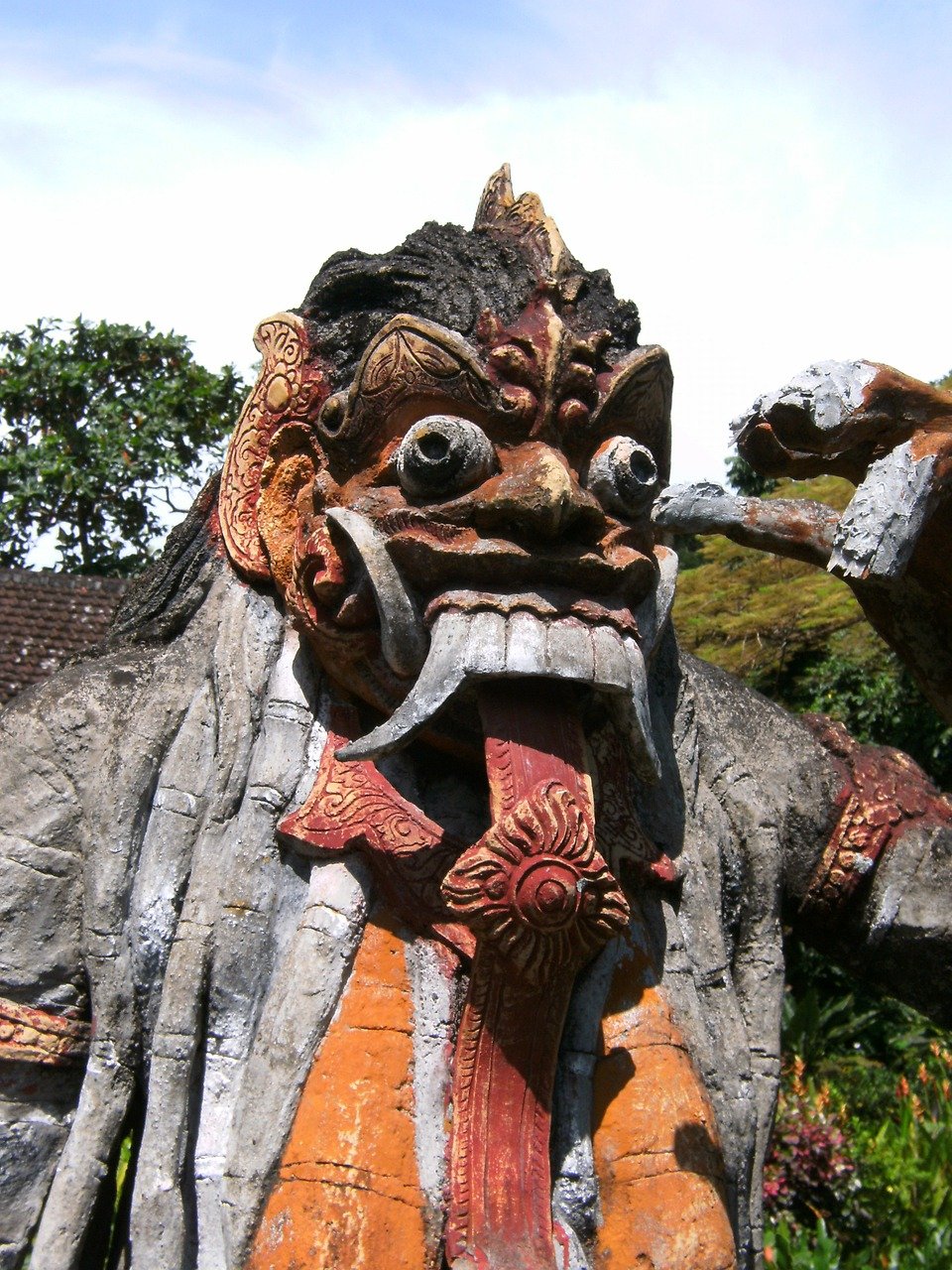Blood Sacrifice in Balinese Religion: Understanding the Rituals and Beliefs
Warning: This article contains themes that may be disturbing to some readers
Image by Aryok Mateus from Pixabay
Table of Contents Show
Blood sacrifice and its role in Balinese religion
In the vibrant and culturally rich island of Bali, Indonesia, the Hindu faith is deeply ingrained in the daily lives of its people. Balinese Hinduism is a unique blend of Hinduism, animism, and ancestral worship, resulting in a fascinating tapestry of rituals and beliefs.
One of the most intriguing aspects of Balinese Hinduism is the practice of blood sacrifice, known as "caru," which is performed to placate the powerful demons, bhutas and kalas. In this article, we will dive into the rituals, symbolism, and significance of blood sacrifice in Balinese religion, shedding light on this ancient tradition that plays a vital role in the spiritual fabric of the island.
The Purpose of Blood Sacrifice
In Balinese Hinduism, it is believed that the universe is composed of both positive and negative forces.
While the gods are to be worshiped, the demons, represented by bhutas and kalas, must be placated due to their immense power. These demons are known for their insatiable appetites and are associated with the dark, animalistic aspects of both the physical world and human nature.
Blood sacrifice, or caru, is performed as a means to satiate these demons and maintain a delicate balance between good and evil, order and chaos.
Understanding Bhuta Kala
To truly comprehend the significance of blood sacrifice in Balinese religion, we must explore the concept of bhuta kala.
Bhuta and kala are Sanskrit words that go beyond the simple notion of "demons." Bhuta refers to the gross elements that make up the human body and also signifies uncanny beings or goblins. Kala, on the other hand, translates to "time," "fate," and "god of death."
In Balinese belief, bhutas and kalas are supernatural demons, often depicted in menacing carvings with bulging eyes and fiendish fangs. However, they also symbolize the dark, animalistic aspects of both the individual and the universe. Bhutas and kalas represent greed, passion, and hunger, both within humans and in the world at large.
Caru: A Spectrum of Sacrifice
Caru is the overarching term for the various types of blood sacrifices offered to the bhutas and kalas. These sacrifices accompany the bhuta yadnya, one of the five divisions of Hindu-Balinese ritual.
The scale of caru offerings can range from a simple sacrifice of a single chicken to elaborate ceremonies involving the slaughter of numerous animals and the creation of large vegetable offerings.
The purpose of caru is to satisfy the bhutas and kalas, with larger sacrifices intended to maintain their appeasement for a longer period of time. However, it is important to note that the goal of caru is not to eradicate or drive out evil, but rather to appease and restore balance.
The Rituals and Symbolism of Caru
Caru ceremonies in Bali involve a meticulous arrangement of offerings dedicated to the bhutas and kalas. These offerings are often far from aesthetically pleasing, comprising of rotted fruit, withered leaves, and chunks of decaying meat.
The bhutas are not picky eaters, but to truly satisfy their hunger, fresh blood from a slaughtered animal must be provided. The offerings are placed on the ground, symbolizing the "low" realm associated with the bhutas and kalas.
A small caru offering, known as segehan, may consist of folded coconut leaves, cooked white rice, salt, and slices of onion and ginger, representing the balance of opposing forces.
The Role of Caru in Purification and Balance
Bhuta yadnya, the set of rituals associated with caru, serves the purpose of purifying the world from the disruptive influences of bhuta kala. Balinese Hinduism acknowledges the coexistence of good and evil, emphasizing the need to maintain a delicate equilibrium.
Caru acts as a means to smooth and annul the imbalances caused by bhutas and kalas, both in the external world and within individuals. By making sacrifices to appease the negative forces, worshippers aim to clear their minds of negative thoughts, allowing them to engage in prayer and connect with the divine.
Different Types of Caru Sacrifices
Caru sacrifices are not limited to a singular form; they vary in scale and complexity based on the occasion and purpose. The smallest caru offering is known as eka sata, which involves the sacrifice of one brunbun chicken.
This type of caru is typically performed during the dedication or purification ceremony of a new building.
Panca sata, on the other hand, requires the sacrifice of five chickens of different colors, representing the four cardinal points and a brunbun chicken at the center.
This type of caru is commonly performed during village crossroads ceremonies and temple festivals.
The Magnitude of Taur and Eka Dasa Rudra
At the pinnacle of caru sacrifices are taur and Eka Dasa Rudra ceremonies. Taur, meaning "pay," is a titanic undertaking reserved for the most significant occasions. It involves the sacrifice of various animals, including chickens, dogs, geese, water buffaloes, and even rare species like garuda eagles and Bengal cats.
Taur ceremonies are performed during events such as the yearly taur kesanga at Besakih and the grand Eka Dasa Rudra, which occurs once every hundred years. These massive ceremonies require meticulous preparations and signify the highest level of devotion and reverence.
The Tabuh Rah: Blood Spilling and Cockfights
In addition to caru sacrifices, blood spilling plays a crucial role in Balinese rituals. During various ceremonies, a small chick or a male pig is sacrificed, and their blood is spilled on the ground. This act, known as tabuh rah, is a form of offering for the bhutas and kalas.
Cockfights, called tajen, also provide an opportunity for blood to spill and are considered essential for appeasing the negative forces.
While gambling is generally prohibited, public cockfights are allowed in connection with temple ceremonies. The blood spilled during these fights is believed to please the bhutas and kalas.
The Symbolism of Colors in Offerings
Colors hold significant symbolism in Balinese offerings, particularly in caru ceremonies.
The Balinese universe is represented by an eight-pointed figure, with Siwa, the supreme god, at the center. Each direction is associated with a specific god, color, and other attributes.
The colors used in caru offerings mimic the symbolism of the nine directions, known as nawa sanga. These colors include black, green, blue, yellow, white, orange, pink, and red.
The careful arrangement of rice piles in the eight directions, surrounding a mixture of all colors in the center, signifies the goal of bringing balance and order to the universe.
Conclusion: Embracing the Traditions of Blood Sacrifice
Blood sacrifice, or caru, remains an integral part of Balinese Hinduism, reflecting the island's deep-rooted spiritual beliefs and practices.
Through caru ceremonies, the Balinese people seek to maintain harmony between the positive and negative forces of the universe. The rituals and symbolism associated with caru offerings provide a profound insight into the intricate tapestry of Balinese religion, where reverence for the divine and an understanding of the duality of existence are paramount.
As we explore the vibrant culture of Bali, we can embrace the traditions of blood sacrifice with respect and appreciation for the profound spiritual significance they hold for the Balinese people.
Fascinated? You might also like to read about: Household Shrines: Exploring the Spiritual World of Balinese Homes and The Significance of Offerings in Balinese Religion
Frequently asked questions about blood sacrifice in Bali's religion
What is blood sacrifice in Balinese religion?
Blood sacrifice is a ritual practice in Balinese religion that involves the slaughtering of animals, such as pigs or chickens, as an offering to the deities and spirits. The blood of the animal is believed to have spiritual power and is used to purify and appease the spirits.
What is the significance of blood sacrifice in Balinese religion?
Blood sacrifice is seen as a way to honor and appease the deities and spirits, seeking their blessings and protection. It is believed to maintain spiritual balance and harmony within the community and to ensure the well-being of individuals and the environment.
What are some of the common animals used in blood sacrifice in Bali?
Common animals used in blood sacrifice in Bali include pigs, chickens, and sometimes even water buffalo. The choice of animal may vary depending on the purpose of the sacrifice and the local customs.
How is blood sacrifice performed in Balinese religion?
Blood sacrifice is typically performed by a priest or a designated individual who slaughters the animal in a specific manner, following traditional rituals and prayers. The blood of the animal is then used in various ways, such as being sprinkled on offerings or used to purify sacred objects.
How does blood sacrifice reflect the Balinese philosophy of Tri Hita Karana?
Blood sacrifice reflects the Balinese philosophy of Tri Hita Karana by emphasizing the harmony between humans, nature, and the divine. It is seen as a way to maintain balance and spiritual harmony within the community and to ensure the well-being of all three realms.
Are there any specific rules or customs associated with blood sacrifice in Balinese religion?
Yes, there are specific rules and customs associated with blood sacrifice in Balinese religion. For example, the animal must be slaughtered in a specific manner, and the blood must be used in a respectful and appropriate way. Additionally, the sacrifice must be performed by a designated individual, such as a priest or a respected member of the community.
How does blood sacrifice reflect the Balinese belief in karma?
Blood sacrifice reflects the Balinese belief in karma by emphasizing the idea that every action has consequences. The act of sacrificing an animal is believed to generate karma, which can affect the spiritual well-being of the individual and the community.
Are there any specific occasions or festivals where blood sacrifice is particularly significant?
Yes, blood sacrifice is particularly significant during certain occasions and festivals in Bali, such as temple anniversaries and other important religious ceremonies. During these events, elaborate sacrifices may be performed to honor the deities and spirits.
How does blood sacrifice contribute to the preservation of Balinese cultural heritage?
Blood sacrifice is an integral part of Balinese cultural heritage and is passed down through generations. The traditional rituals and practices associated with blood sacrifice help to preserve and promote Balinese culture. They serve as a way to maintain and celebrate the unique customs and traditions of Bali.
How do Balinese people view the act of killing animals for blood sacrifice?
Balinese people view the act of killing animals for blood sacrifice as a necessary and respectful practice. They believe that the animal is being sacrificed for a higher purpose and that its sacrifice is a way to honor and appease the deities and spirits.
How does blood sacrifice reflect the Balinese belief in the interconnectedness of all things?
Blood sacrifice reflects the Balinese belief in the interconnectedness of all things by emphasizing the idea that humans, animals, and the environment are all part of a larger spiritual system. The sacrifice of an animal is seen as a way to maintain balance and harmony within this system.
How does blood sacrifice contribute to the sense of community and togetherness in Bali?
Blood sacrifice is often performed as a communal practice, bringing together members of the community to honor and appease the deities and spirits. The act of sacrificing an animal together fosters a sense of unity and togetherness among the Balinese people.
Are there any specific rules or customs associated with the preparation of animals for blood sacrifice?
Yes, there are specific rules and customs associated with the preparation of animals for blood sacrifice. For example, the animal must be healthy and free from any defects or illnesses. It must also be treated with respect and care before and during the sacrifice.
How does blood sacrifice reflect the Balinese belief in the power of ritual?
Blood sacrifice reflects the Balinese belief in the power of ritual by emphasizing the importance of traditional practices and prayers. The ritual of blood sacrifice is seen as a way to connect with the deities and spirits and to seek their blessings and protection.
How does blood sacrifice contribute to the overall spiritual ecology of Bali?
Blood sacrifice is believed to contribute to the overall spiritual ecology of Bali by maintaining balance and harmony between humans, nature, and the divine. It is seen as a way to ensure the well-being of all three realms and to promote spiritual growth and development.
How does blood sacrifice reflect the Balinese belief in the cyclical nature of life and death?
Blood sacrifice reflects the Balinese belief in the cyclical nature of life and death by emphasizing the idea that death is a necessary part of the spiritual cycle. The sacrifice of an animal is seen as a way to honor and respect this cycle and to ensure that the spiritual balance is maintained.






















Bali's remarkable rice terraces draw numerous tourists. However, could tourism pose a threat that the age-old Subak system might struggle to overcome?